Vinod C Dixit([email protected])The United Nations has proclaimed May 22 as The International Day for Biological Diversity to increase understanding and awareness of biodiversity issues. Biodiversity remains the answer to several sustainable development challenges. From nature-based solutions to climate, health issues, food and water security, and sustainable livelihoods, biodiversity is the foundation upon which we can build back better.The theme in 2022 is ‘Building a shared future for all life’. It is an umbrella term for the degree of nature’s variety including both the number and frequency of ecosystems, species or genes in a given assemblage. Thus, the term ‘biodiversity’ refers to the totality of ‘genes, species and ecosystems’ of a region. Biodiversity is defined as “the variability among living organisms from all sources, including terrestrial, marine and other aquatic ecosystems and the ecological complexes of which they are a part; this includes diversity within species between species and of ecosystems.”India shows a great diversity in climate, topography and geology and hence it is very rich in biodiversity. India is famous for its biological diversity in the world. It has five distinct bio-diversity zones, which are known for their rich fauna and flora. In every zone the plants and animals have their distinct nature, ecological importance and a different way of inhabitation. The Ministry of Environment and Forests, Government of India (2000), recorded 47,000 species of plants and 81,000 species of animals. This is about 7% and 6.5% respectively of global flora and fauna. India occupies only about 2.4 per cent of the world’s land area, but its contribution to the world’s biodiversity is approximately 8% of the total number of species, which is estimated to be 1.75 million. Of these, 1,26,188 have been described in India. Humans derive many direct and indirect benefits from biological diversity. All our food comes from wild species brought into domestication. Most of our medicines, pharmaceuticals, fibres, rubber and timber come from biological resources. The biodiversity also provides many ecological services free of charge that are responsible for maintaining ecosystems. All life forms, whether big or small, have important roles to play in their ecosystem. Together, they form the fundamentals of healthy and well-functioning processes in nature that supply abundant oxygen, water and a variety of food types, imperative for the survival of all beings. These pathways are well-linked and inter-dependent for providing all essential ecosystem services. We are dependent on a variety of life forms for pollination, control of pests, enhancing growth of plants for more food, production of medicines and many other routine utility items in our households. It is very necessary to access the factors which are hampering in the growth of population of the species such as decimating (death) factors like diseases, predators, etc., or scarcity of food, water and shelter. We humans are a part of biodiversity. We need to stop behaving as the Supreme Being at the top of the hierarchy of all life forms. If this attitude of blindly exploiting biodiversity for our own benefit while disregarding the balanced survival of other living forms continues, we will pave a path for our own extinction much earlier.
From: sentinel
URL: https://www.sentinelassam.com/editorial/biodiversity-is-more-precious-than-diamonds-593092



